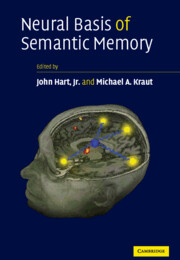Book contents
- Frontmatter
- Contents
- List of contributors
- Preface
- Part I Semantic Memory: Building Models from Lesions
- 1 Semantic refractory access disorders
- 2 The anatomical locus of lesion in category-specific semantic disorders and the format of the underlying conceptual representations
- Part II Insights from Electrophysiology
- Part III Applications of Models to Understanding Cognitive Dysfunction
- Part IV Representations of Nouns and Verbs vs. Objects and Actions
- Part V Critical Role of Subcortical Nuclei in Semantic Functions
- Part VI Conceptual Models of Semantics
- Index
- References
2 - The anatomical locus of lesion in category-specific semantic disorders and the format of the underlying conceptual representations
from Part I - Semantic Memory: Building Models from Lesions
Published online by Cambridge University Press: 14 September 2009
- Frontmatter
- Contents
- List of contributors
- Preface
- Part I Semantic Memory: Building Models from Lesions
- 1 Semantic refractory access disorders
- 2 The anatomical locus of lesion in category-specific semantic disorders and the format of the underlying conceptual representations
- Part II Insights from Electrophysiology
- Part III Applications of Models to Understanding Cognitive Dysfunction
- Part IV Representations of Nouns and Verbs vs. Objects and Actions
- Part V Critical Role of Subcortical Nuclei in Semantic Functions
- Part VI Conceptual Models of Semantics
- Index
- References
Summary
Our knowledge of the world is based upon two main kinds of cognitive processes: perceptual activities, which continuously give us information about external objects and actions performed with these objects; and conceptual activities, which allow us to have stable internal representations of objects, actions, and more abstract entities. However, in spite of the complementary nature of these two kinds of cognitive activities, and of the fact that sensory–motor functions certainly play a preliminary role in the acquisition of conceptual knowledge, there is a discrepancy between the large amount of information available about the nature, mechanisms, and neural basis of perceptual activities and the very poor and controversial knowledge that we still have about the nature and the neural substrates of conceptual representations. This lack of solidly established knowledge concerns two main aspects of the semantic–conceptual activities, namely the format of the semantic representations and the neuroanatomical substrates of concepts. On the contrary, there is general agreement that concepts are categorically organized in the brain. The aim of the present chapter is to show that format and categorical organization of semantic representations are strictly intermingled and that the study of the anatomical lesions underlying category-specific semantic disorders can contribute to clarifying the nature of these intimate relationships.
The plan that I intend to follow in the development of this chapter will, therefore, consist of the following steps: (i) I shall discuss the problem of the format of the semantic representations and of their relationships with the underlying sensory–motor activities; (ii) I shall, then, take into account the question of the categorical organization of semantic knowledge, focusing on the most relevant and debated dichotomies, namely on the distinction between category-specific disorders for actions (verbs) and for objects (nouns) and, within the latter, on the distinction between living things and artifacts.
Keywords
- Type
- Chapter
- Information
- Neural Basis of Semantic Memory , pp. 28 - 62Publisher: Cambridge University PressPrint publication year: 2007
References
- 1
- Cited by

